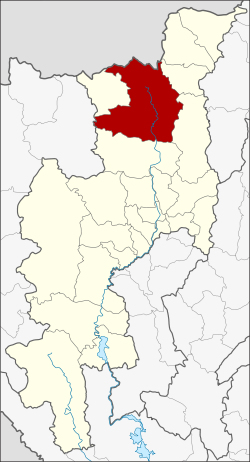Chiang Dao district
Chiang Dao
เชียงดาว | |
|---|---|
 Rice paddies with Doi Chiang Dao in the clouds | |
 Amphoe location in Chiang Mai Province | |
| Country | |
| Province | Chiang Mai |
| Area | |
• Total | 1,882.1 km2 (726.7 sq mi) |
| Population (2000) | |
• Total | 87,922 |
| • Density | 46.7/km2 (121/sq mi) |
| Time zone | UTC+7 (ICT) |
| Postal code | 50170 |
| Geocode | 5004 |
Chiang Dao (Template:Lang-th) is a district (amphoe) of Chiang Mai Province in northern Thailand. It is nicknamed "little Tuscany" and there are actually a few local wines produced in the area.
Geography
Neighboring districts are (from the north-east clockwise) Fang, Chai Prakan, Phrao, Mae Taeng of Chiang Mai Province, Pai of Mae Hong Son Province, and Wiang Haeng of Chiang Mai again. To the north is the Shan State of Myanmar.
Chiang Dao is the only district in Thailand that has all twelve hill tribes in residence.
The Chiang Dao Wildlife Sanctuary, with over 300 species of birds, surrounds the mountain of Doi Chiang Dao.[1] Pha Daeng National Park is another nature reserve located within the district.
The Ping River, one of the main tributaries to the Chao Phraya River, originates at Doi Thuai, in the mountains of the Daen Lao Range in Chiang Dao District. The Taeng River, a river that has its source in the mountains of the Daen Lao Range in neighbouring Wiang Haeng District, also flows through Chiang Dao District on its way to its confluence with the Ping River in Mae Taeng District.
History
Chiang Dao was a smaller city state (mueang) in the northern Thai Lan Na kingdom. As part of the thesaphiban administrative reforms at the end of the 19th century it was made a district in Chiang Mai Province.
Originally a minor district (king amphoe), it was upgraded to a full district in 1908.[2]
Administration
The district is subdivided into seven subdistricts (tambon), which are further subdivided into 83 villages (muban). Both Chiang Dao and Mueang Ngai are subdistrict municipalities (thesaban tambon), which cover parts of the same-named tambon. The subdistrict municipality Phra That Pu Kam (พระธาตุปู่ก่ำ) covers the remaining parts of the subdistrict Mueang Ngai. Mueang Na, Ping Khong and Thung Khao Phuang are further subdistrict municipalities which cover the whole same-named subdistrict. There are further three Tambon administrative organizations (TAO) - Mae Na and Mueang Khong covering the whole same-named subdistrict, and Chiang Dao the non-municipal parts of the subdistrict.
| No. | Name | Thai | Villages | Inh. |
|---|---|---|---|---|
| 1. | Chiang Dao | เชียงดาว | 16 | 15,194 |
| 2. | Mueang Na | เมืองนะ | 14 | 31,574 |
| 3. | Mueang Ngai | เมืองงาย | 11 | 6,513 |
| 4. | Mae Na | แม่นะ | 13 | 9,782 |
| 5. | Mueang Khong | เมืองคอง | 6 | 4,244 |
| 6. | Ping Khong | ปิงโค้ง | 16 | 11,606 |
| 7. | Thung Khao Phuang | ทุ่งข้าวพวง | 7 | 9,009 |
References
- ^ http://www.lonelyplanet.com/thailand/chiang-mai-province/chiang-dao/sights/parks-gardens/doi-chiang-dao-wildlife-sanctuary
- ^ แจ้งความกระทรวงมหาดไทย (PDF). Royal Gazette (in Thai). 25 (15): 447–448. 1908-07-12.
External links
 Chiang Dao travel guide from Wikivoyage
Chiang Dao travel guide from Wikivoyage
